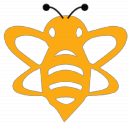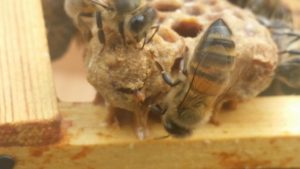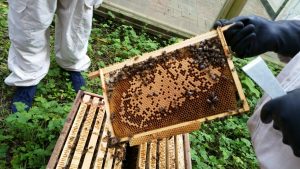Honey Bee Haven
The Black Bee Experience

Honey Bee Haven
The Black Bee Experience
Life in the Hive
When you look outside a hive you will see many bees flying, these are bees out collecting nectar and pollen and taking it back to the hive to make bee bread and honey.
But this is only half the story.
The foraging bees are older honey bees (over 22 days old) and spend the rest of their days collecting the ingredients for bee food from flowers. In a single flight your average honey bee will fly 2.5 miles (native honey bees will fly up to 5 miles) and visit up to 1500 flowers. If you look carefully on the back of them you will see little packets of colour, this is the pollen they have collected from various plants, and you can actually tell which plants they’ve attended by the colour of the pollen.
Unlike other bees, honey bees remain faithful to one flower. This means that when they visit flowers they are carrying the right sort of pollen for the next flower they visit, which is why it is all one colour. When they return to the hive with their quarry they are first greeted by guard bees.
Guard bees, as the name suggests, are there to protect the hive entrance from invaders such as wasps and honey bees from other hives who may try and rob the hive of it’s honey. honey bees take up guard duties at 14 days old. If you watch carefully at the hive entrance you can see certain honey bees greeting and checking the incoming foragers to make sure they should be there. Of course, if they aren’t they will be asked to leave.
Once the foragers are past the guard bees they meet the house bees. These look after the internal workings of the hive and have a number of responsibilities depending on their age. The house bees that collect the part processed honey and nectar from the foraging bees will take this food stock and store it in the wax honeycomb on the frames in the hive.
Older house bees produce wax from special glands on their stomachs in order to make the bees wax needed for honeycomb. They chew honey which goes through the glands which produce small discs of wax from honey, they going these together to form the wax combs that we all recognise.
The cells the nectar and honey are stored in within the comb are capped with wax when full, preserving them for later use. The pollen is mixed with honey to make ‘bee bread’ this is fed to larvae, along with honey, in the last four days before they are capped with breathable  wax so they may metamorphosize into an adult bee. It is is the middle aged house bees that feed the larvae this food.
wax so they may metamorphosize into an adult bee. It is is the middle aged house bees that feed the larvae this food.
On emerging from the wax comb the honey bee will be fully formed, having mutated from being a larvae. Exhausted, they will eat through the wax cap over many hours. Starving, she will be greeted by nurse bees who will feed her to ensure she survives.
The first few days after her emergence she will spend time getting used to the hive and cleaning her cell that she has just left, preparing it for the next bee egg. Once this has been done, her roles will focus on keeping the hive clean, until her food glands develop. At this stage she will take on the role of a nurse bee and feed larvae and young bees.
©Honey Bee Haven Limited 2015